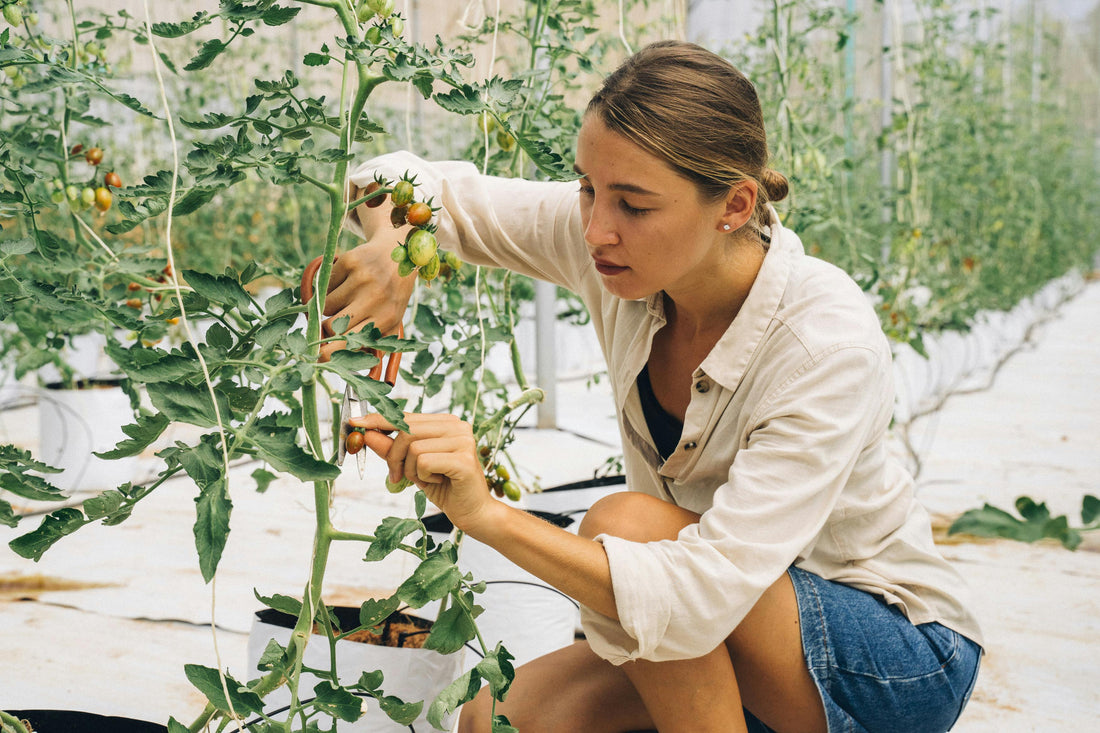Pruning tomato plants can significantly enhance their health and yield. By understanding the appropriate techniques and timing, you can ensure your tomato plants flourish.
Why Prune Tomatoes?
Pruning is essential to improve air circulation, reduce the risk of disease, and focus the plant’s energy on fruit production rather than excessive foliage growth. It helps in managing the plant size and promotes earlier ripening of fruits.
Types of Tomato Plants
- Determinate Tomatoes: These plants grow to a fixed size and produce all their fruit in a short period. Pruning is minimal; just remove the suckers below the first flower cluster to prevent them from turning into extra stems.
- Indeterminate Tomatoes: These grow continuously throughout the season, producing fruit until frost. Regular pruning is crucial to manage their growth and maximize fruit production.
Pruning Techniques
- Removing Suckers: Suckers are small shoots that grow in the axils between the stem and a branch. For indeterminate varieties, remove these suckers regularly to maintain a single main stem. This directs the plant's energy into fruit production.
- Lower Leaf Removal: Once the first fruits set, remove the lower leaves to enhance air circulation and reduce the risk of soil-borne diseases.
- Topping the Plant: Towards the end of the growing season, topping or cutting off the top of the plant can redirect energy into ripening the remaining fruits rather than producing new flowers and foliage.
Steps to Prune
- Identify Suckers: Look for small shoots in the leaf axils.
- Use Clean Tools: Use sterilized scissors or pruners to avoid spreading diseases.
- Pinch or Cut: Pinch off small suckers with your fingers. For larger ones, use a clean cutting tool.
- Monitor Regularly: Check your plants weekly and remove any new suckers.

Timing
Begin pruning when the plant is about 12-18 inches tall and continues throughout the growing season. Always prune in dry weather to minimize disease spread.
Benefits of Pruning
Pruned plants are easier to support with stakes or cages, have better air circulation, and are more manageable. This results in healthier plants and potentially higher yields.
By incorporating these pruning practices, your tomato plants can thrive, offering a bountiful harvest.
Pruning tomato plants can significantly enhance their health and yield. By understanding the appropriate techniques and timing, you can ensure your tomato plants flourish.
Why Prune Tomatoes?
Pruning is essential to improve air circulation, reduce the risk of disease, and focus the plant’s energy on fruit production rather than excessive foliage growth. It helps in managing the plant size and promotes earlier ripening of fruits.
Types of Tomato Plants
- Determinate Tomatoes: These plants grow to a fixed size and produce all their fruit in a short period. Pruning is minimal; just remove the suckers below the first flower cluster to prevent them from turning into extra stems.
- Indeterminate Tomatoes: These grow continuously throughout the season, producing fruit until frost. Regular pruning is crucial to manage their growth and maximize fruit production.
Pruning Techniques
- Removing Suckers: Suckers are small shoots that grow in the axils between the stem and a branch. For indeterminate varieties, remove these suckers regularly to maintain a single main stem. This directs the plant's energy into fruit production.
- Lower Leaf Removal: Once the first fruits set, remove the lower leaves to enhance air circulation and reduce the risk of soil-borne diseases.
- Topping the Plant: Towards the end of the growing season, topping or cutting off the top of the plant can redirect energy into ripening the remaining fruits rather than producing new flowers and foliage.

Steps to Prune
- Identify Suckers: Look for small shoots in the leaf axils.
- Use Clean Tools: Use sterilized scissors or pruners to avoid spreading diseases.
- Pinch or Cut: Pinch off small suckers with your fingers. For larger ones, use a clean cutting tool.
- Monitor Regularly: Check your plants weekly and remove any new suckers.
Timing
Begin pruning when the plant is about 12-18 inches tall and continues throughout the growing season. Always prune in dry weather to minimize disease spread.
Benefits of Pruning
Pruned plants are easier to support with stakes or cages, have better air circulation, and are more manageable. This results in healthier plants and potentially higher yields.
By incorporating these pruning practices, your tomato plants can thrive, offering a bountiful harvest.

